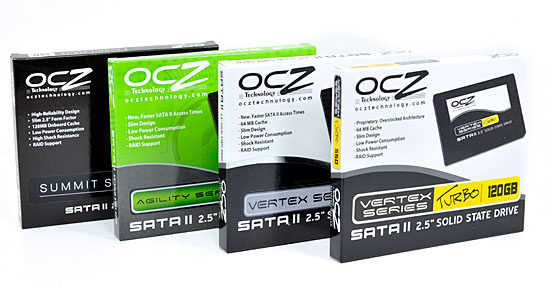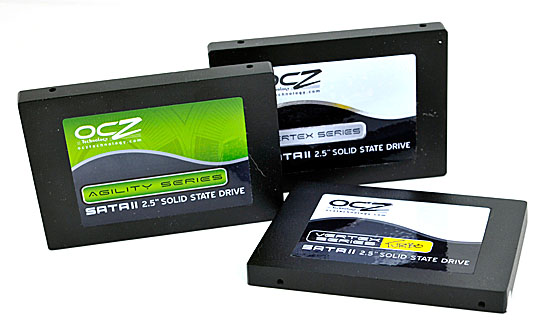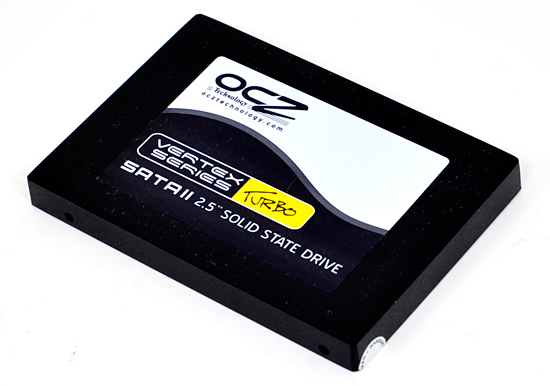The SSD Relapse: Understanding and Choosing the Best SSD
by Anand Lal Shimpi on August 30, 2009 12:00 AM EST- Posted in
- Storage
The OCZ Vertex Turbo: Overclocked Indilinx
I’ll have to give it to OCZ’s CEO Ryan Petersen, he always tries. The SSD race is once again heating up and he’s determined to compete on more than just price. OCZ’s entire Indilinx line of drives are going to be cheaper (at least in cost per GB) than Intel’s, but OCZ is also adding new drives to the lineup.

The Vertex and Agility we’re both familiar with. The Vertex EX is the SLC version and now we have the Vertex Turbo. The Turbo is a Vertex but with a faster controller and DRAM cache: 180MHz vs. 166MHz for the stock Vertex. It's not a physically different controller, it's just one that has been binned to run at 180MHz. OCZ helps Indilinx validate its drives and in exchange for that, Indilinx gives OCZ the exclusivity on 180MHz controllers.

We’re talking about an 8% increase in controller and DRAM frequency. If we’re lucky, we might reduce the time some instructions take to complete by a few nanoseconds. The problem is that we’re fundamentally bottlenecked by the performance of the NAND flash itself, which operates on the order of microseconds. In other words: don’t expect a performance boost.

We've already seen that these Indilinx drives can vary in performance by a few percent from drive to drive, so in order to make the comparison as accurate as possible I did all of my tests on the Vertex Turbo. After I was done running my Turbo tests I simply threw on the standard Vertex firmware, which specifies a 166MHz controller/DRAM clock.
| New Performance | OCZ Vertex | OCZ Vertex Turbo | Turbo Advantage |
| 4KB Random Write | 13.2 MB/s | 13.6 MB/s | 3% |
| 2MB Sequential Write | 175.9 MB/s | 184.2 MB/s | 4.7% |
As expected, there’s very little performance difference here. You'd see the same sorts of differences between two different Indilinx MLC drives. My Torqx sample from Patriot was as fast as my Vertex Turbo sample. OCZ charges a huge premium for the Turbo drive though:
| Price for 128GB | |
| OCZ Vertex | $369.00 |
| OCZ Vertex Turbo | $439.00 |
| Turbo Premium | 19% |
It's up to the price of a 160GB Intel X25-M G2, absolutely not worth it. I talked with Ryan Petersen, OCZ's CEO about the Turbo and its lack of value. As usual, we argued a bit but eventually gave me his vision. He wants to bring 180MHz controllers to all Vertex drives, and not charge premiums for it. His intentions are to improve how competitive OCZ's drives are in a sea of equal-performing Indilinx drives.
While I wouldn't recommend spending more money on the Turbo, if OCZ brings 180MHz controllers to all of its drives I won't complain.










295 Comments
View All Comments
Anand Lal Shimpi - Monday, August 31, 2009 - link
The tables the drive needs to operate are also stored in a small amount of flash on the drive. The start of the circular logic happens in firmware which points to the initial flash locations, which then tells the controller how to map LBAs to flash pages.Take care,
Anand
Bakkone - Monday, August 31, 2009 - link
Any gossip about the new SATA?Zaitsev - Monday, August 31, 2009 - link
Thanks for the great article, Anand! It's been quite entertaining thus far.cosmotic - Monday, August 31, 2009 - link
The page about sizes (GB, GiB, spare areas, etc) is very confusing. It sounds very much like you are confusing the 'missing' space when converting from GB to GiB with the space the drive is using for its spare area.Is it the case that the drive has 80GiB internally, uses 5.5GiB for spare, and reports it's size as 80GB to the OS leaving the OS to say 74.5GiB as usable?
Anand Lal Shimpi - Monday, August 31, 2009 - link
I tried to keep it simply by not introducing the Gibibyte but I see that I failed there :)You are correct, the drive has 80GiB internally, uses 5.5GiB for spare and reports that it has 156,301,488 sectors (or 74.5GiB) of user addressable space.
Take care,
Anand
sprockkets - Tuesday, September 1, 2009 - link
Weird. So what you are saying is, the drive has 80Gib capacity, but then reports it has 80GB to the OS, advertised as having an 80GB capacity, which the OS then says the capacity is 74.5GiB?sprockkets - Tuesday, September 1, 2009 - link
As a quick followup, this whole SI vs binary thing needs to be clarified using the proper terms, as people like Microsoft and others have been saying GB when it really is GiB (or was the GiB term invented later?)For those who want a quick way to convert:
http://converter.50webs.com">http://converter.50webs.com
ilkhan - Monday, August 31, 2009 - link
so they are artifically bringing the capacity down, because the drive has the full advertised capacity and is getting the "normal" real capacity. :argh:Vozer - Monday, August 31, 2009 - link
I tried looking for the answer, but haven't found it anywhere so here it is: There are 10 flash memory blocks on both Intel 160GB and 80GB X25-M G2, right? (and 20 blocks with the G1).So, is the 80GB version actually a 160GB with some bad blocks or do they actually produce two different kind of flash memory block to use on their drives?
Anand Lal Shimpi - Monday, August 31, 2009 - link
While I haven't cracked open the 80GB G2 I have here, I don't believe the drives are binned for capacity. The 80GB model should have 10 x 8GB NAND flash devices on it, while the 160GB model should have 10 x 16GB NAND flash devices.Take care,
Ananad